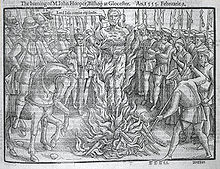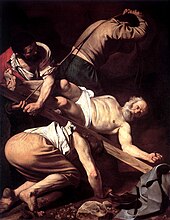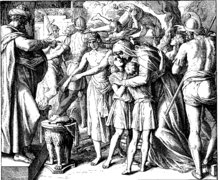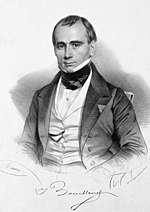Religious persecution may be triggered by religious bigotry (i.e. members of a dominant group denigrating religions other than their own) or by the state when it views a particular religious group as a threat to its interests or security. At a societal level, this dehumanisation of a particular religious group may readily turn into violence or other forms of persecution. Indeed, in many countries, religious persecution has resulted in so much violence that it is considered a human rights problem.
Definition
Religious
persecution is defined as violence or discrimination against religious
minorities, actions intending to deprive political rights and force
minorities to assimilate, leave, or live as second-class citizen. In the aspect of state policy, it may be defined as violations on freedom of thought, conscience
and belief spread by systematic and active state policy and actions of
harassment, intimidation and punishment that infringes or threatens the right to life, integrity or liberty. The distinction with religious intolerance is that the latter in most cases is in the sentiment of the population, which may be tolerated or encouraged by the state. Denial of civil rights on the basis of religion is most often described as religious discrimination, rather than religious persecution.
Examples of persecution is confiscation or destruction of
property, incitement to hate, arrest, imprisonment, beatings, torture,
murder, and execution. Religious persecution can be considered the
opposite of freedom of religion.
Bateman has differentiated different degrees of persecution. "It
must be personally costly... It must be unjust and undeserved... it
must be a direct result of one's faith."
Forms
Cleansing
"Religious cleansing" is a term that is sometimes used to refer to
the removal of a population from a certain territory based on its
religion. Throughout antiquity,
population cleansing was largely motivated by economic and political
factors, although ethnic factors occasionally played a role. During the Middle Ages, population cleansing took on a largely religious character.
The religious motivation lost much of its salience early in the modern
era, although until the 18th century ethnic enmity in Europe remained
couched in religious terms. Richard Dawkins has argued that references to ethnic cleansing in the former Yugoslavia and Iraq are euphemisms for what should more accurately be called religious cleansing. According to Adrian Koopman, the widespread use of the term ethnic cleansing in such cases suggests that in many situations there is confusion between ethnicity and religion.
Ethnicity
During Nazi rule, Jews were forced to wear yellow stars identifying them as such. Jews are an ethno-religious group and Nazi persecution was based on their race
Other acts of violence, such as war, torture, and ethnic cleansing
not aimed at religion in particular, may nevertheless take on the
qualities of religious persecution when one or more of the parties
involved are characterized by religious homogeneity; an example being
when conflicting populations that belong to different ethnic groups
often also belong to different religions or denominations. The
difference between religious and ethnic identity might sometimes be
obscure; cases of genocide in the 20th century cannot be explained in full by citing religious differences. Still, cases such as the Greek genocide, the Armenian Genocide, and the Assyrian Genocide are sometimes seen as religious persecution and blur the lines between ethnic and religious violence.
Since the Early modern period, there were increased religious cleansing entwined with ethnic elements.
As religion is an important or central marker in ethnic identity, some
conflicts can be described as "ethno-religious conflicts".
Nazi antisemitism provides another example of the contentious divide between ethnic and religious persecution, because Nazi propaganda tended to construct its image of Jews as race, and de-emphasized Jews as being defined by their religion. The Holocaust made no distinction between secular Jews, atheistic Jews, orthodox Jews and Jews that had converted to Christianity. The Nazis also persecuted the Catholic Church in Germany and Poland.
Persecution for heresy and blasphemy
The persecution of beliefs that are deemed schismatic is one thing;
the persecution of beliefs that are deemed heretical or blasphemous is
another. Although a public disagreement on secondary matters might be
serious enough, it has often only led to religious discrimination.
A public renunciation of the core elements of a religious doctrine
under the same circumstances would, on the other hand, have put one in
far greater danger. While dissenters
from the official Church only faced fines and imprisonment in
Protestant England, six people were executed for heresy or blasphemy
during the reign of Elizabeth I, and two more were executed in 1612 under James I.
Similarly, heretical sects like Cathars, Waldensians and Lollards were brutally suppressed in Western Europe, while, at the same time, Catholic Christians lived side-by-side with 'schismatic' Orthodox Christians after the East-West Schism in the borderlands of Eastern Europe.
Persecution for political reasons
Protestant Bishop John Hooper was burned at the stake by Queen Mary I of England
More than 300 Roman Catholics were put to death by English governments between 1535 and 1681 for treason, thus for secular rather than religious offenses. In 1570, Pope Pius V issued his papal bull Regnans in Excelsis, which absolved Catholics from their obligations to the government. This dramatically worsened the situation of the Catholics in England. English governments continued to fear the fictitious Popish Plot. The 1584 Parliament of England, declared in "An Act against Jesuits, seminary priests, and such other like disobedient persons" that the purpose of Jesuit missionaries who had come to Britain was "to stir up and move sedition, rebellion and open hostility". Consequently, Jesuit priests like Saint John Ogilvie were hanged. This somehow contrasts with the image of the Elizabethan era as the time of William Shakespeare, but compared to the antecedent Marian Persecutions there is an important difference to consider. Mary I of England
had been motivated by a religious zeal to purge heresy from her land,
and during her short reign from 1553 to 1558 about 290 Protestants had been burned at the stake for heresy, whereas Elizabeth I of England "acted out of fear for the security of her realm."
By location
The
descriptive use of the term religious persecution is rather difficult.
Religious persecution has occurred in different historical, geographical
and social contexts since at least antiquity. Until the 18th century, some groups were nearly universally persecuted for their views about religion, such as atheists, Jews, and Zoroastrians.
Roman Empire
Saint Peter, an apostle of Jesus, was executed by the Romans
Early Christianity
also came into conflict with the Roman Empire, and may have been more
threatening to the established polytheistic order than had been Judaism,
because of the importance of evangelism in Christianity. Under Nero,
the Jewish exemption from the requirement to participate in public
cults was lifted and Rome began to actively persecute monotheists. This
persecution ended in 313 AD with the Edict of Milan,
and Christianity was made the official religion of the empire in 380
AD. By the eighth century Christianity had attained a clear ascendancy
across Europe and neighboring regions, and a period of consolidation
began marked by the pursuit of heretics, heathens, Jews, Muslims, and various other religious groups.
Early modern England
One period of religious persecution which has been extensively studied is early modern England, since the rejection of religious persecution, now common in the Western world, originated there. The English 'Call for Toleration' was a turning point in the Christian debate on persecution and toleration,
and early modern England stands out to the historians as a place and
time in which literally "hundreds of books and tracts were published
either for or against religious toleration."
The most ambitious chronicle of that time is W.K.Jordan's magnum opus The Development of Religious Toleration in England, 1558-1660 (four volumes, published 1932-1940). Jordan wrote as the threat of fascism rose in Europe, and this work is seen as a defense of the fragile values of humanism and tolerance. More recent introductions to this period are Persecution and Toleration in Protestant England, 1558–1689 (2000) by John Coffey and Charitable hatred. Tolerance and intolerance in England, 1500-1700
(2006) by Alexandra Walsham. To understand why religious persecution
has occurred, historians like Coffey "pay close attention to what the
persecutors said they were doing."
Ecclesiastical dissent and civil tolerance
No
religion is free from internal dissent, although the degree of dissent
that is tolerated within a particular religious organization can
strongly vary. This degree of diversity tolerated within a particular
church is described as ecclesiastical tolerance, and is one form of religious toleration. However, when people nowadays speak of religious tolerance, they most often mean civil tolerance, which refers to the degree of religious diversity that is tolerated within the state.
In the absence of civil toleration, someone who finds himself in
disagreement with his congregation doesn't have the option to leave and
chose a different faith - simply because there is only one recognized
faith in the country (at least officially). In modern western civil law
any citizen may join and leave a religious organization at will; In
western societies, this is taken for granted, but actually, this legal separation of Church and State only started to emerge a few centuries ago.
In the Christian debate on persecution and toleration, the notion of civil tolerance allowed Christian theologians to reconcile Jesus' commandment to love one's enemies with other parts of the New Testament that are rather strict regarding dissent within the church. Before that, theologians like Joseph Hall
had reasoned from the ecclesiastical intolerance of the early Christian
church in the New Testament to the civil intolerance of the Christian
state.
Europe
Religious uniformity in early modern Europe
By contrast to the notion of civil tolerance, in early modern Europe the subjects were required to attend the state church; This attitude can be described as territoriality or religious uniformity, and its underlying assumption is brought to a point by a statement of the Anglican theologian Richard Hooker:
"There is not any man of the Church of England but the same man is also
a member of the [English] commonwealth; nor any man a member of the
commonwealth, which is not also of the Church of England."
Before a vigorous debate about religious persecution took place
in England (starting in the 1640s), for centuries in Europe, religion
had been tied to territory. In England there had been several Acts of Uniformity; in continental Europe the Latin phrase "cuius regio, eius religio" had been coined in the 16th century and applied as a fundament for the Peace of Augsburg (1555). It was pushed to the extreme by absolutist regimes, particularly by the French kings Louis XIV and his successors. It was under their rule that Catholicism became the sole compulsory allowed religion in France and that the huguenots
had to massively leave the country. Persecution meant that the state
was committed to secure religious uniformity by coercive measures, as
eminently obvious in a statement of Roger L'Estrange: "That which you call persecution, I translate Uniformity".
However, in the 17th century writers like Pierre Bayle, John Locke, Richard Overton
and Roger William broke the link between territory and faith, which
eventually resulted in a shift from territoriality to religious
voluntarism. It was Locke who, in his Letter Concerning Toleration, defined the state in purely secular terms:
"The commonwealth seems to me to be a society of men constituted only
for the procuring, preserving, and advancing their own civil interests."
Concerning the church, he went on: "A church, then, I take to be a
voluntary society of men, joining themselves together of their own
accord." With this treatise, John Locke laid one of the most important intellectual foundations of the separation of church and state, which ultimately led to the secular state.
Russia
The
Bishop of Vladimir Feodor turned some people into slaves, others were
locked in prison, cut their heads, burnt eyes, cut tongues or crucified
on walls. Some heretics were executed by burning them alive. According
to an inscription of Khan Mengual-Temir, Metropolitan Kiril was granted
the right to heavily punish with death for blasphemy against the
Orthodox Church or breach of ecclesiastical privileges. He advised all
means of destruction to be used against heretics, but without bloodshed,
in the name of 'saving souls'. Heretics were drowned. Novgorod Bishop
Gennady Gonzov turned to Tsar Ivan III requesting the death of heretics. Gennady admired the Spanish inquisitors, especially his contemporary Torquemada, who for 15 years of inquisition activity burned and punished thousands of people.
As in Rome, persecuted fled to depopulated areas. The most terrible
punishment was considered an underground pit, where rats lived. Some
people had been imprisoned and tied to the wall there, and untied after
their death. Old Believers
were persecuted and executed, the order was that even those renouncing
completely their beliefs and baptized in the state Church to be lynched
without mercy. The writer Lomonosov
opposed the religious teachings and by his initiative a scientific book
against them was published. The book was destroyed, the Russian synod
insisted Lomonosov's works to be burned and requested his punishment.
...were cutting heads, hanging, some by the neck, some by the foot, many of them were stabbed with sharp sticks and impaled on hooks. This included the tethering to a ponytail, drowning and freezing people alive in lakes. The winners did not spare even the sick and the elderly, taking them out of the monastery and throwing them mercilessly in icy 'vises'. The words step back, the pen does not move, in eternal darkness the ancient Solovetsky monastery is going. Of the more than 500 people, only a few managed to avoid the terrible court.
Contemporary
Although his book was written before the September 11 attacks, John Coffey explicitly compares the English fear of the Popish Plot with the contemporary Islamophobia in the Western world. Among the Muslims imprisoned in the Guantanamo Bay detention camp there also were Mehdi Ghezali and Murat Kurnaz who could not have been found to have any connections with terrorism, but had traveled to Afghanistan and Pakistan because of their religious interests.
By religion
Persecutions of atheists
Used before the 18th century as an insult, atheism was punishable by death in ancient Greece, in ancient Israel, in Christian countries during the Middle Ages and in Muslim countries. Today, atheism is punishable by death in 13 countries (Afghanistan, Iran, Malaysia, Maldives, Mauritania, Nigeria, Pakistan, Qatar, Saudi Arabia, Somalia, Sudan, United Arab Emirates and Yemen),
all of them Muslim, while "the overwhelming majority" of the 192 United
Nation member countries "at best discriminate against citizens who have
no belief in a god and at worst can jail them for offences dubbed
blasphemy".
State atheism
State atheism has been defined by David Kowalewski as the official "promotion of atheism" by a government, typically by active suppression of religious freedom and practice. It is a misnomer referring to a government's anti-clericalism,
which opposes religious institutional power and influence, real or
alleged, in all aspects of public and political life, including the
involvement of religion in the everyday life of the citizen.
State atheism was first practised during a brief period in Revolutionary France and repeated only in Revolutionary Mexico and Communist states. The Soviet Union had a long history of state atheism,
in which social success largely required individuals to profess
atheism, stay away from churches and even vandalize them; this attitude
was especially militant during the middle Stalinist era from 1929-1939. The Soviet Union attempted to suppress religion over wide areas of its influence, including places like central Asia, and the post-World War II Eastern bloc. One state within that bloc, the Socialist People's Republic of Albania under Enver Hoxha, went so far as to officially ban all religious practices.
Persecution of Baha'is
The Bahá'ís
are Iran's largest religious minority, and Iran is the location of one
of the largest Bahá'í populations in the world. Bahá'ís in Iran have
been subject to unwarranted arrests, false imprisonment, beatings,
torture, unjustified executions, confiscation and destruction of
property owned by individuals and the Bahá'í community, denial of
employment, denial of government benefits, denial of civil rights and
liberties, and denial of access to higher education.
More recently, in the later months of 2005, an intensive
anti-Bahá'í campaign was conducted by Iranian newspapers and radio
stations. The state-run and influential Kayhan newspaper, whose managing editor is appointed by Iran's supreme leader, Ayatollah Khamenei,
ran nearly three dozen articles defaming the Bahá'í Faith. Furthermore,
a confidential letter sent on October 29, 2005 by the Chairman of the
Command Headquarters of the Armed Forced in Iran states that the Supreme
Leader of Iran, Ayatollah Khamenei
has instructed the Command Headquarters to identify people who adhere
to the Bahá'í Faith and to monitor their activities and gather any and
all information about the members of the Bahá'í Faith. The letter was
brought to the attention of the international community by Asma
Jahangir, the Special Rapporteur of the United Nations Commission on Human Rights on freedom of religion or belief, in a March 20, 2006 press release.
In the press release the Special Rapporteur states that she "is
highly concerned by information she has received concerning the
treatment of members of the Bahá'í community in Iran." She further
states that "The Special Rapporteur is concerned that this latest
development indicates that the situation with regard to religious
minorities in Iran is, in fact, deteriorating.".
Persecution of Buddhists
Persecution of Buddhists was a widespread phenomenon throughout the
history of Buddhism lasting to this day, beginning as early as the 3rd
century AD by the Zoroastrian Sassanid Empire. Anti-Buddhist sentiments
in Imperial China between the 5th and 10th century led to the Four Buddhist Persecutions in China of which the Great Anti-Buddhist Persecution
of 845 was probably the most severe. In the 20th century Buddhists were
persecuted by Asian communist states and parties, Imperial Japan and by
the Kuomintang among others.
Persecution of Christians
According to tradition, early Christians were fed to lions in the Colosseum of Rome
The persecution of Christians is for the most part, historical. Even from the beginnings of the religion as a movement within Judaism, Early Christians were persecuted for their faith at the hands of both Jews and the Roman Empire, which controlled much of the areas where Christianity was first distributed. This continued from the first century until the early fourth, when the religion was legalised by the Edict of Milan, eventually becoming the State church of the Roman Empire.
Today, Christians are persecuted in Iran for proselytising. Proselytising is illegal in Iran.
Persecution of Falun Gong
The persecution of the Falun Gong spiritual practice began with campaigns initiated in 1999 by the Chinese Communist Party to eliminate Falun Gong in China. It is characterised by multifaceted propaganda
campaign, a program of enforced ideological conversion and
re-education, and a variety of extralegal coercive measures such as
arbitrary arrests, forced labor, and physical torture, sometimes resulting in death.
There have being reports of Organ harvesting of Falun Gong practitioners in China. Several researchers—most notably Canadian human rights lawyer David Matas, former parliamentarian David Kilgour, and investigative journalist Ethan Gutmann—estimate that tens of thousands of Falun Gong prisoners of conscience have been killed to supply a lucrative trade in human organs and cadavers.
Persecution of Hindus
The Bangladesh Liberation War
(1971) resulted in one of the largest genocides of the 20th century.
While estimates of the number of casualties was 3,000,000, it is
reasonably certain that Hindus bore a disproportionate brunt of the
Pakistan Army's onslaught against the Bengali population of what was
East Pakistan. An article in Time magazine
dated 2 August 1971, stated "The Hindus, who account for three-fourths
of the refugees and a majority of the dead, have borne the brunt of the
Muslim military hatred." Senator Edward Kennedy wrote in a report that was part of United States Senate Committee on Foreign Relations
testimony dated 1 November 1971, "Hardest hit have been members of the
Hindu community who have been robbed of their lands and shops,
systematically slaughtered, and in some places, painted with yellow
patches marked "H". All of this has been officially sanctioned, ordered
and implemented under martial law from Islamabad".
In the same report, Senator Kennedy reported that 80% of the refugees
in India were Hindus and according to numerous international relief
agencies such as UNESCO and World Health Organization
the number of East Pakistani refugees at their peak in India was close
to 10 million. Given that the Hindu population in East Pakistan was
around 11 million in 1971, this suggests that up to 8 million, or more
than 70% of the Hindu population had fled the country.The Pulitzer Prize–winning journalist Sydney Schanberg
covered the start of the war and wrote extensively on the suffering of
the East Bengalis, including the Hindus both during and after the
conflict. In a syndicated column "The Pakistani Slaughter That Nixon
Ignored", he wrote about his return to liberated Bangladesh in 1972.
"Other reminders were the yellow "H"s the Pakistanis had painted on the
homes of Hindus, particular targets of the Muslim army" (by "Muslim
army", meaning the Pakistan Army, which had targeted Bengali Muslims as well), (Newsday, 29 April 1994).
Hindus constitute approximately 0.5% of the total population of the United States. Hindus in the US enjoy both de jure and de facto legal equality. However, a series of attacks were made on people Indian origin by a street gang called the "Dotbusters" in New Jersey in 1987, the dot signifying the Bindi dot sticker worn on the forehead by Indian women.
The lackadaisical attitude of the local police prompted the South Asian
community to arrange small groups all across the state to fight back
against the street gang. The perpetrators have been put to trial. On 2
January 2012, a Hindu worship center in New York City was firebombed. The Dotbusters were primarily based in New York and New Jersey and committed most of their crimes in Jersey City.
A number of perpetrators have been brought to trial for these assaults.
Although tougher anti-hate crime laws were passed by the New Jersey
legislature in 1990, the attacks continued, with 58 cases of hate crimes
against Indians in New Jersey reported in 1991.
In Bangladesh, on 28 February 2013, the International Crimes Tribunal sentenced Delwar Hossain Sayeedi, the Vice President of the Jamaat-e-Islami to death for the war crimes committed during the 1971 Bangladesh Liberation War. Following the sentence, activists of Jamaat-e-Islami and its student wing Islami Chhatra Shibir
attacked the Hindus in different parts of the country. Hindu properties
were looted, Hindu houses were burnt into ashes and Hindu temples were
desecrated and set on fire. While the government has held the Jamaat-e-Islami responsible for the attacks on the minorities, the Jamaat-e-Islami
leadership has denied any involvement. The minority leaders have
protested the attacks and appealed for justice. The Supreme Court of
Bangladesh has directed the law enforcement to start suo motu investigation into the attacks. US Ambassador to Bangladesh express concern about attack of Jamaat on Bengali Hindu community. The violence included the looting of Hindu properties and businesses, the burning of Hindu homes, rape of Hindu women and desecration and destruction of Hindu temples. According to community leaders, more than 50 Hindu temples and 1,500 Hindu homes were destroyed in 20 districts.
Persecutions of Jews
Woodcut of the Seleucid persecution depicting martyrs refusing to sacrifice from Die Bibel in Bildern
A major component of Jewish history, persecutions have been committed by Seleucids, ancient Greeks,
ancient Romans, Christians (Catholics, Orthodox and Protestant),
Muslims, Communists, Nazis, etc. Some of the most important events
constituting this history include the 1066 Granada massacre, the Rhineland massacres, the Alhambra Decree after the Reconquista and the creation of the Spanish Inquisition, the publication of On the Jews and Their Lies by Martin Luther which furthered Protestant anti-Judaism and was later used to strengthen German antisemitism in pogroms and the Holocaust.
Persecution of Samaritans
The Samaritan Temple at Mount Gerizim was destroyed by John Hyrcanus
in about 128 BC, partly because it was attracting some northern Jews as
a place of worship. In 107 BC, Hyrcanus destroyed Schechem. In the seventeenth century, Muslims from Nablus forced some Samaritans to convert to Islam and forbade access to Mount Gerizim.
Persecution of Muslims
The French military in Algeria
Persecution of Muslims is the religious persecution inflicted upon followers of the Islamic faith. In the early days of Islam at Mecca, the new Muslims were often subjected to abuse and persecution by the pagan Meccans (often called Mushrikin: the unbelievers or polytheists).
Muslims have been the target of persecution ever since the emergence of Islam, sometimes to the point of being martyred for their faith.
In the 20th century, Muslims were persecuted by various governments including Myanmar, French, Italia, China, and many more.
Persecution of minorities in Islamic lands
Victims of Muslim persecution include Jews, Christians, Zoroastrians, Hindus, Buddhists, Bahá'ís,, Serers, and Atheists. Muslim persecution of fellow Muslims include as victims Shia, Ahmadis, Sufi, Alevis and Salafis.
Persecutions of Sikhs
The 1984 anti-Sikhs riots were a series of pogroms directed against Sikhs in India, by anti-Sikh mobs, in response to the assassination of Indira Gandhi by her Sikh bodyguards. There were more than 8,000 deaths, including 3,000 in Delhi. In June 1984, during Operation Blue Star, Indira Gandhi ordered the Indian Army to attack the Golden Temple and eliminate any insurgents, as it had been occupied by Sikh separatists who were stockpiling weapons. Later operations by Indian paramilitary forces were initiated to clear the separatists from the countryside of Punjab state.
The violence in Delhi was triggered by the assassination of
Indira Gandhi, India's prime minister, on 31 October 1984, by two of her
Sikh bodyguards in response to her actions authorising the military operation. After the assassination following Operation Blue Star, many Indian National Congress workers including Jagdish Tytler, Sajjan Kumar
and Kamal Nath were accused of inciting and participating in riots
targeting the Sikh population of the capital. The Indian government
reported 2,700 deaths in the ensuing chaos. In the aftermath of the
riots, the Indian government reported 20,000 had fled the city, however
the People's Union for Civil Liberties reported "at least" 1,000 displaced persons. The most affected regions were the Sikh neighbourhoods in Delhi. The Central Bureau of Investigation,
the main Indian investigating agency, is of the opinion that the acts
of violence were organized with the support from the then Delhi police
officials and the central government headed by Indira Gandhi's son, Rajiv Gandhi.
Rajiv Gandhi was sworn in as Prime Minister after his mother's death
and, when asked about the riots, said "when a big tree falls (Mrs.
Gandhi's death), the earth shakes (occurrence of riots)" thus trying to
justify communal strife.
There are allegations that the Indian National Congress government at that time destroyed evidence and shielded the guilty. The Asian Age front-page story called the government actions "the Mother of all Cover-ups"
There are allegations that the violence was led and often perpetrated
by Indian National Congress activists and sympathisers during the riots.
The government, then led by the Congress, was widely criticised for
doing very little at the time, possibly acting as a conspirator. The conspiracy theory
is supported by the fact that voting lists were used to identify Sikh
families. Despite their communal conflict and riots record, the Indian National Congress claims to be a secular party.
Persecution of Serers
The persecution of the Serer people of Senegal, the Gambia and Mauritania
is multifaceted, and it includes both religious and ethnic elements.
Religious and ethnic persecution of the Serer people dates back to the
11th century when King War Jabi usurped the throne of Tekrur (part of present-day Senegal) in 1030, and by 1035, introduced Sharia law and forced his subjects to submit to Islam. With the assistance of his son (Leb), their Almoravid allies and other African ethnic groups who have embraced Islam, the Muslim coalition army launched jihads against the Serer people of Tekrur who refused to abandon Serer religion in favour of Islam.
The number of Serer deaths are unknown, but it triggered the exodus of
the Serers of Tekrur to the south following their defeat, where they
were granted asylum by the lamanes. Persecution of the Serer people continued from the medieval era to the 19th century, resulting in the Battle of Fandane-Thiouthioune.
From the 20th to the 21st centuries, persecution of the Serers is less
obvious, nevertheless they are the object of scorn and prejudice.









